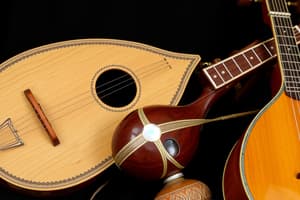Podcast
Questions and Answers
What family do strings belong to?
What family do strings belong to?
- Brass
- Percussion
- Woodwinds
- Strings (correct)
What type of instruments produce sound from vibrating columns of air?
What type of instruments produce sound from vibrating columns of air?
Woodwinds
Brass instruments produce sound primarily through what?
Brass instruments produce sound primarily through what?
- Plucking strings
- Buzzing lips (correct)
- Blowing across a mouth hole
- Striking with sticks
What classification do instruments like the xylophone and tambourine fall under?
What classification do instruments like the xylophone and tambourine fall under?
What is the most natural musical instrument?
What is the most natural musical instrument?
Which classification produces sound from tightly stretched membranes?
Which classification produces sound from tightly stretched membranes?
Which instrument belongs to the family of strings and is classified as a chordophone?
Which instrument belongs to the family of strings and is classified as a chordophone?
The snare drum is classified as an idiophone.
The snare drum is classified as an idiophone.
The clarinet is a woodwind instrument.
The clarinet is a woodwind instrument.
What classification do instruments that create sound from vibrating strings fall under?
What classification do instruments that create sound from vibrating strings fall under?
What is a common characteristic of percussion instruments?
What is a common characteristic of percussion instruments?
Flashcards
Woodwind
Woodwind
Instruments that produce sound by vibrating air in a pipe. They can have single reeds like the clarinet or double reeds like the oboe.
Strings
Strings
Instruments that create sound from vibrating strings, typically played with a bow, plucked, or struck.
Brass
Brass
Instruments with a cup-shaped mouthpiece and flared tubing. Sound is produced by buzzing lips.
Percussion
Percussion
Instruments that produce sound by being struck. Divided into idiophones and membranophones.
Signup and view all the flashcards
Voice
Voice
The most natural musical instrument, producing sound using vocal cords.
Signup and view all the flashcards
Aerophones
Aerophones
Instruments that produce sound through vibrating air. Examples include the flute, oboe, and trumpet.
Signup and view all the flashcards
Membranophones
Membranophones
Instruments that produce sound from stretched membranes. Examples include the snare drum and bass drum.
Signup and view all the flashcards
Idiophones
Idiophones
Instruments that produce sound from their own material, without vibrating membranes or air. Examples include the xylophone, triangle, and cymbals.
Signup and view all the flashcards
Chordophones
Chordophones
Instruments that generate sound from vibrating strings. Examples include the violin, guitar, and piano.
Signup and view all the flashcards
Harp
Harp
A large stringed instrument known for its rich and melodic sound.
Signup and view all the flashcards
Saxophone
Saxophone
A woodwind instrument with a single reed, blending characteristics of brass and woodwinds.
Signup and view all the flashcardsStudy Notes
Instrument Families and Classifications
- Strings: Instruments producing sound by bowing, plucking, or striking strings. Notable examples include the violin, viola, cello, and double bass.
- Woodwinds: Instruments that create sound from vibrating air in a pipe. Can feature single reeds (clarinet, saxophone) or double reeds (oboe, bassoon).
- Brass: Instruments with cup-shaped mouthpieces and flared tubing. Sound is produced by buzzing lips, with examples such as trumpet, French horn, and tuba.
- Percussion: Instruments producing sound by being struck. Includes idiophones (xylophone, cymbals) and membranophones (snare drum, timpani).
- Voice: The most natural musical instrument with unique qualities and vocal ranges, including soprano, mezzo-soprano, tenor, and bass.
Instrument Classifications
- Aerophones: Instruments producing sound through vibrating air (e.g., flute, oboe).
- Chordophones: Instruments generating sound from vibrating strings (e.g., violin, harp).
- Idiophones: Instruments that produce sound from their own material (e.g., tambourine, triangle).
- Membranophones: Instruments that create sound from stretched membranes (e.g., snare drum, bass drum).
Specific Instruments Overview
- Violin: A string instrument and a chordophone; essential in orchestras.
- Flute: A woodwind aerophone; played by blowing across a mouth hole.
- Trumpet: A brass aerophone; known for its brilliant tone.
- Timpani: A percussion membranophone; utilized in orchestral settings for rhythmic foundation.
- Piano: A keyboard instrument classified under strings, functioning as a chordophone with a unique mechanism for sound production.
Unique Features of Instruments
- Harp: A large stringed instrument, noted for its rich and melodic sound.
- Saxophone: A woodwind instrument with a single reed, blending characteristics of brass and woodwinds.
- Mandolin: A stringed instrument with a distinct, bright tone; frequently used in folk music.
- Glockenspiel: A mallet percussion idiophone, producing bright, bell-like sounds.
- Organ: A keyboard aerophone; associated with both classical and church music.
Conclusion
Understanding these families and classifications of instruments provides insight into their diverse sound production methods and their roles in musical compositions. Each category represents a unique approach to creating and experiencing music.
Studying That Suits You
Use AI to generate personalized quizzes and flashcards to suit your learning preferences.




